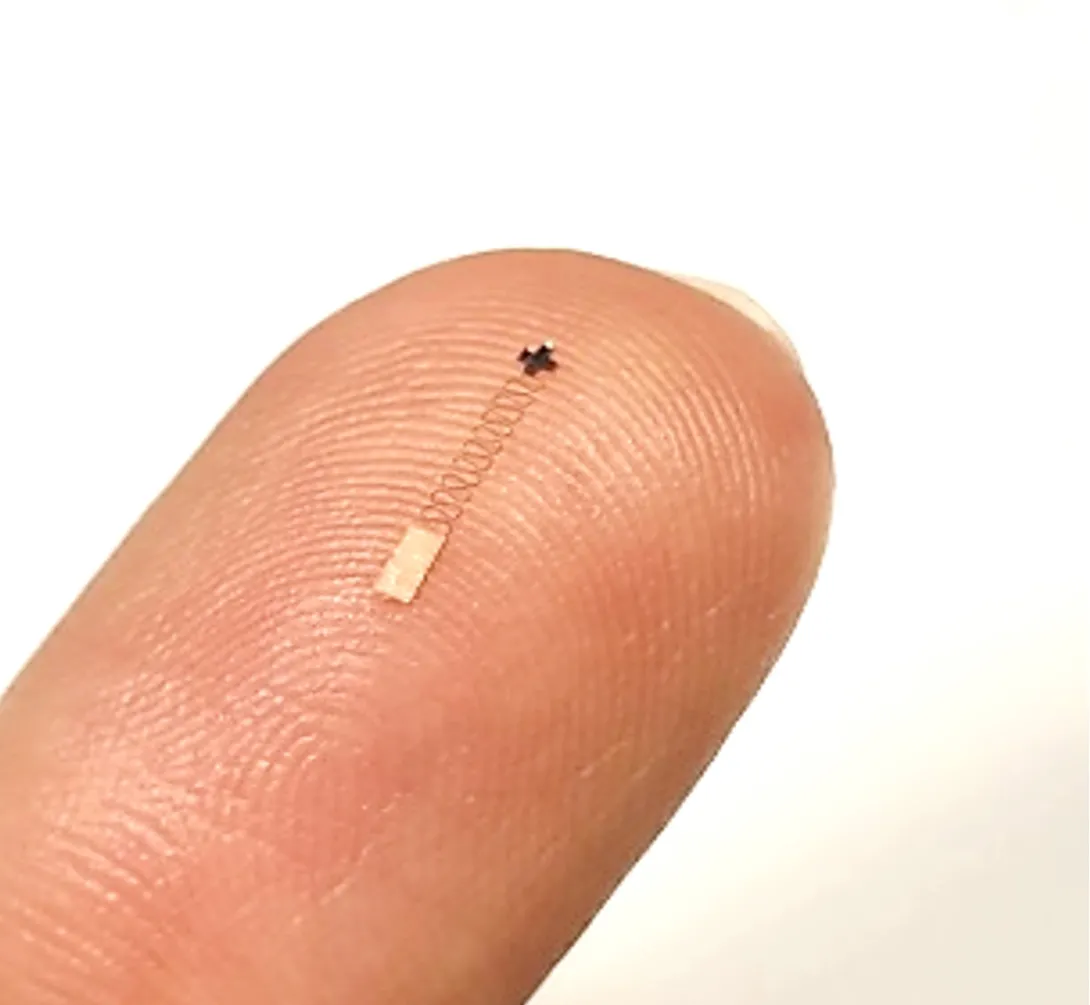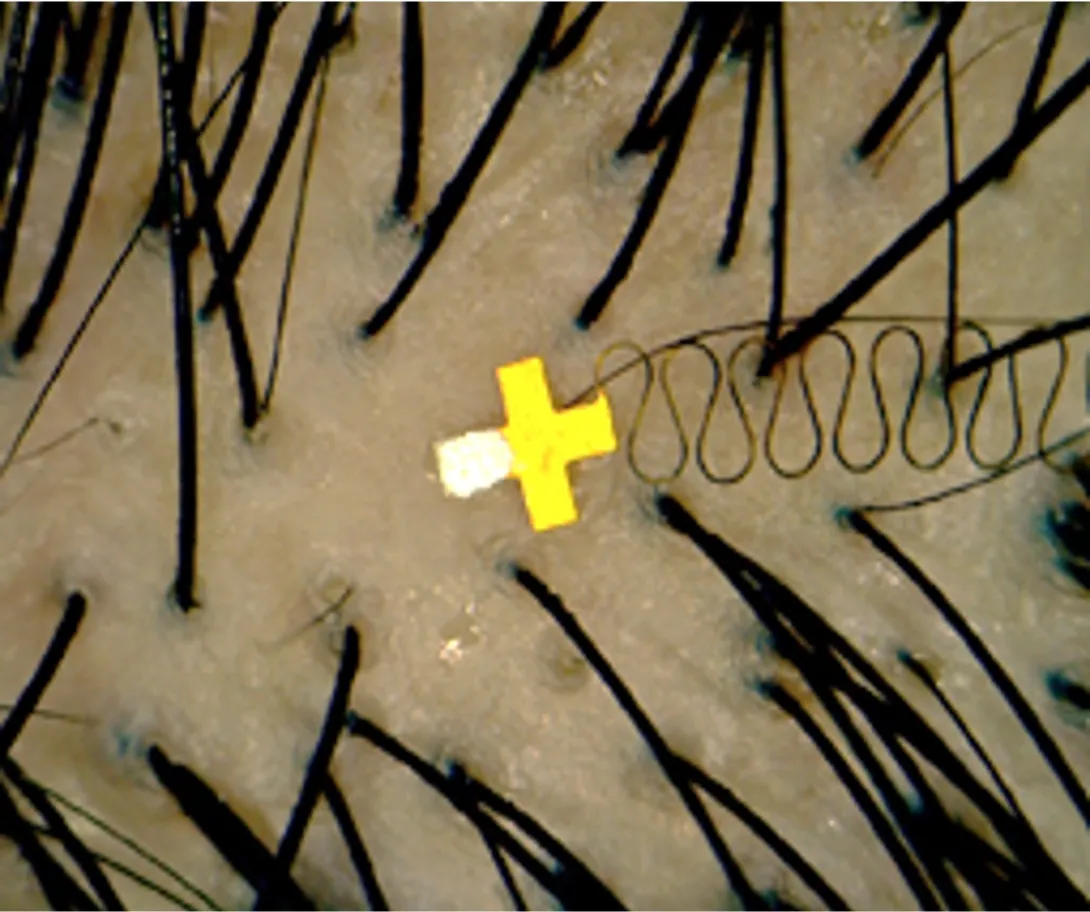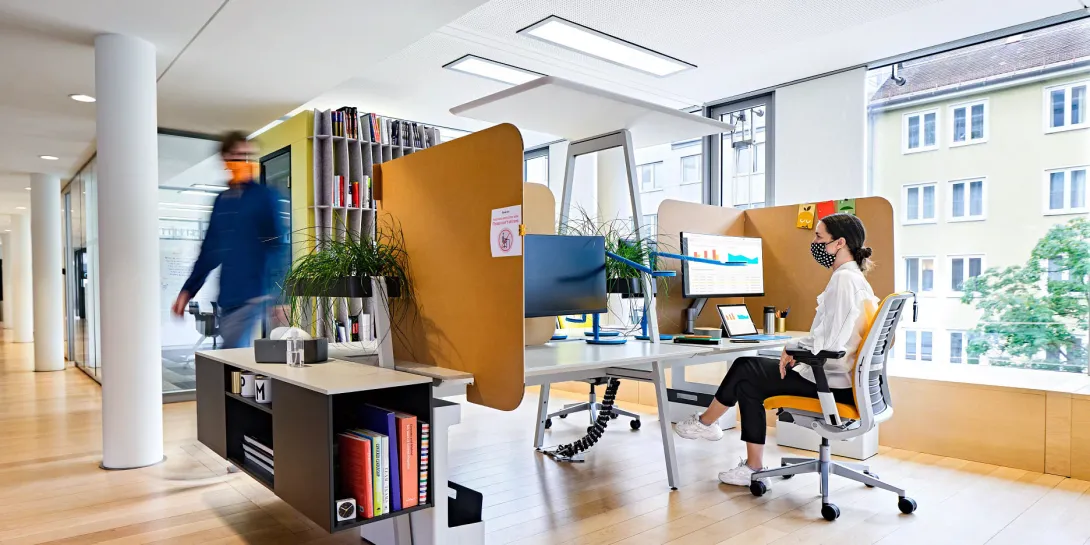Apr. 07, 2025
Micro-brain sensors placed between hair strands overcome traditional brain sensor limitations.
Georgia Tech researchers have developed an almost imperceptible microstructure brain sensor to be inserted into the minuscule spaces between hair follicles and slightly under the skin. The sensor offers high-fidelity signals and makes the continuous use of brain-computer interfaces (BCI) in everyday life possible.
BCIs create a direct communication pathway between the brain's electrical activity and external devices such as electroencephalography devices, computers, robotic limbs, and other brain monitoring devices. Brain signals are commonly captured non-invasively with electrodes mounted on the surface of the human scalp using conductive electrode gel for optimum impedance and data quality. More invasive signal capture methods such as brain implants are possible, but this research seeks to create sensors that are both easily placed and reliably manufactured.
Hong Yeo, the Harris Saunders Jr. Professor in the George W. Woodruff School of Mechanical Engineering, combined the latest microneedle technology with his deep expertise in wearable sensor technology that may allow stable brain signal detection over long periods and easy insertion of a new painless, wearable microneedle BCI wireless sensor that fits between hair follicles. The skin placement and extremely small size of this new wireless brain interface could offer a variety of benefits over traditional gel or dry electrodes.
“I started this research because my main goal is to develop new sensor technology to support healthcare and I had previous experience with brain-computer interfaces and flexible scalp electronics,” said Yeo, who is also a faculty member in Georgia Tech’s Institute for People and Technology. “I knew we needed better BCI sensor technology and discovered that if we can slightly penetrate the skin and avoid hair by miniaturizing the sensor, we can dramatically increase the signal quality by getting closer to the source of the signals and reduce unwanted noise.”
Today’s BCI systems consist of bulky electronics and rigid sensors that prevent the interfaces from being useful while the user is in motion during regular activities. Yeo and colleagues constructed a micro-scale sensor for neural signal capture that can be easily worn during daily activities, unlocking new potential for BCI devices. His technology uses conductive polymer microneedles to capture electrical signals and conveys those signals along flexible polyimide/copper wires — all of which are packaged in a space of less than 1 millimeter.
A study of six people using the device to control an augmented reality (AR) video call found that high-fidelity neural signal capture persisted for up to 12 hours with very low electrical resistance at the contact between skin and sensor. Participants could stand, walk, and run for most of the daytime hours while the brain-computer interface successfully recorded and classified neural signals indicating which visual stimulus the user focused on with 96.4% accuracy. During the testing, participants could look up phone contacts and initiate and accept AR video calls hands-free as this new micro-sized brain sensor was picking up visual stimuli — all the while giving the user complete freedom of movement.
According to Yeo, the results suggest that this wearable BCI system may allow for practical and continuous interface activity, potentially leading to everyday use of machine-human integrative technology.
“I firmly believe in the power of collaboration, as many of today’s challenges are too complex for any one individual to solve,” said Yeo. “Therefore, I would like to express my gratitude to all the researchers in my group and the amazing collaborators who made this work possible. I will continue collaborating with the team to enhance BCI technology for rehabilitation and prosthetics.”
Note: Hodam Kim (postdoctoral research fellow), Ju Hyeon Kim (visiting Ph.D. student from Inha University – South Korea), and Yoon Jae Lee (Ph.D. student) also played a major role in developing this technology.
Funding: National Science Foundation NRT (Research Traineeship program in the Sustainable Development of Smart Medical Devices), WISH Center (Institute for Matter and Systems), and partial research support from several South Korean programs and grants.
PNAS article publication (April 7, 2025, Vol. 122, No. 15): https://www.pnas.org/doi/10.1073/pnas.2419304122
News Contact
Walter Rich, Research Communications
Oct. 20, 2022
The North American Manufacturing Research Institution of SME (NAMRI | SME) has awarded their 2022 Outstanding Lifetime Service Award to Thomas R. Kurfess, professor in the George W. Woodruff School of Mechanical Engineering at Georgia Tech. Kurfess is the executive director of Georgia Tech’s Manufacturing Institute and holds the HUSCO/Ramirez Distinguished Chair in Fluid Power and Motion Control. SME was formerly known as the Society of Manufacturing Engineers. SME, headquartered in Southfield, Michigan, is a professional association dedicated to educating and promoting the manufacturing industry.
Kurfess, and two other Georgia Tech alumni were recognized at the 50th annual North American Manufacturing Research Conference (NAMRC) for their accomplishments in the manufacturing industry.
Georgia Tech alumni Thomas Feldhausen and Kyle Saleeby both received the Sandra L. Bouckley Outstanding Young Manufacturing Engineer Award. The award recognizes exceptional contributions in manufacturing made by engineers 35 or younger.
Kurfess first joined the faculty at Georgia Tech in 1994 and has taken on a variety of special assignments in addition to his teaching and research. From 2019-2021, Kurfess served as the chief manufacturing officer at ORNL, where he was responsible for strategic planning for ORNL in advanced manufacturing. He was also the founding director for ORNL's Manufacturing Science Division. He served as the assistant director for advanced manufacturing at the Office of Science and Technology Policy in the executive office of the President of the United States of America from 2012-2013, where he was responsible for coordinating federal advanced manufacturing research and development. He is the current executive director of the Georgia Tech Manufacturing Institute, having been appointed in June of 2022.
Previously, Kurfess was awarded the SME Albert M. Sargent Progress Award for the development of large-scale computing capabilities leveraging low-cost, high-performance computing systems to analyze large-scale manufacturing metrology data sets.
Kurfess is a member of the National Academy of Engineering and a fellow of the American Association for the Advancement of Science (AAAS), the American Society of Mechanical Engineers (ASME) and the Society of Manufacturing Engineers (SME). He was president of SME in 2018 and currently serves on the ASME Board of Governors.
For more information about these award winners, view the Woodruff School of Mechanical Engineering’s October 19, 2022 news release.
News Contact
Mar. 24, 2022
The Georgia Tech Manufacturing Institute (GTMI) has initiated a search for a the position of Executive Director. The Executive Director provides intellectual leadership and organizational oversight for GTMI. This person will build the manufacturing research portfolio of Georgia Tech by serving as an advocate for research engagement with companies, state and federal government agencies, and other entities within Georgia Tech. As a service-oriented leader, they work with researchers and staff to develop collaborations and initiatives; proactively prepare and coordinate preparation of major research grant applications; build communities of interest across campus; cultivate thought leadership; educate key stakeholders and prepare the future workforce; increase the profile of Georgia Tech and its research community; and otherwise attract research partners to Georgia Tech.
GTMI's mission is to convene industry leaders, government partners and top researchers to collaborate on the grand challenges facing the U.S. manufacturing industry today: accelerating technology development and deployment, creating quality jobs, ensuring global competitiveness, and advancing economic and environmental stability. GTMI moves innovations from the lab to the market, spanning the entire innovation value chain, from raw materials and recycled resources to prototypes and finished products. These efforts include the development of materials, systems, processes, education, and policies that impact the manufacturing marketplace.
Nominations and Applications
All nominations should be directed in confidence to the search committee chair or any member of the search committee. To access the application:
1. Log into OneUSG. You will land on the Employee Self Service Page.
2. Select the Recruiting Self Service Tile, then go to the Recruiting Self Service Page.
3. Click on ‘Apply For Jobs’ tile, then Click on ‘View all jobs’ option.
4. At the top in the search bar type ‘240914’ and press enter
Interested candidates would submit the following application materials:
1. A cover letter not to exceed two pages that summarizes the candidate’s qualifications, includes a brief statement of their vision for GTMI, and articulates their commitment to DEI initiatives
2. A curriculum vitae
3. The names and contact information for three references
While applications and nominations will be received until the Executive Director is selected, interested parties are encouraged to respond by April 4, 2022 at 9 am EDT, to assure full consideration.
News Contact
Walter Rich
Jun. 02, 2021
A stellar product can only get a company so far in today’s global marketplace. A truly successful enterprise needs to be able to make quick adaptations to its manufacturing lines so it can respond as the market changes. It’s a tricky process requiring a deep understanding of the data and the organization’s systems and culture, which is why firms seek the guidance of the Georgia Tech Manufacturing Institute (GTMI).
“We help companies overcome barriers by applying researched technology and Georgia Tech's expertise to the problem,” said Andrew Dugenske, director of the Factory Information Systems Center and principal research engineer at GTMI. He just completed a major effort with Steelcase, a century-plus-old company that designs workspaces around the people who use them.
“We like to say we are students of the workplace,” said Paul Noll, senior researcher at Steelcase. “We watch how people work. We study their behaviors. We study the activity. We learn, and then we build our products and services to support what we see.”
Steelcase approached GTMI, Noll said, not only because of the Institute’s superior reputation in manufacturing but also because they’ve found everyone at Tech has a natural curiosity for both the task and the culture of their partners.
“It was very much the professional work environment at Tech as well as the expertise,” added Edward Vander Bilt, who leads the partnership at Steelcase.
Merging Expertise with Technology
Fundamental to their relationship is the Industrial Internet of Things, a term for using the information from the various sensors, computers, and robotic devices a company uses in manufacturing, to refine, even redefine the way the assembly line operates.
GTMI worked with Steelcase on an array of projects designed to improve the intelligence, responsiveness, and adaptability of their manufacturing lines. In one endeavor, they improved assembly lines by embedding them with Georgia Tech’s digital architecture. The digital systems move information from the lines into the cloud, where it can be processed. Then Steelcase uses the data to decide how to alter manufacturing processes.
“One of the big challenges of manufacturing is that some companies have legacy equipment, so it can't easily transfer the information about its activities into the cloud," said GTMI’s Dugenske. “We have developed a method to retrofit these lines so companies can use the Industrial Internet of Things to their advantage.”
Now the company has expanded this capability to all its lines throughout North America.
“We’ve been using our digital architecture with several companies, and it’s worked really well for them,” added Dugenske.
Collaboration is the Name of the Game
Helping a firm improve elements as indelible as production processes isn’t something that can be accomplished after just a few high-level meetings. It’s a mission that requires understanding the wisdom of employees working on the lines.
“It was extremely collaborative,” said Vander Bilt. “Andrew Dugenske visited all of our factories in North America, observing and talking with the plant managers and leaders in a whole variety of disciplines to better understand how we operate as a company.”
And when it came time to implement the findings, Dugenske headed back on the road to help put those recommendations into practice.
“It was quite intense,” added Vander Bilt, who said that one of the most valuable elements came from working with the graduate and undergraduate students.
Students built and installed prototypes in the factories and worked with Steelcase’s engineers to adjust to the conditions of each location. Vander Bilt said this gave the company high confidence that the solutions were the right ones.
Working at the Intersection of People and Technology
Steelcase and Georgia Tech have been working together since 2005 on projects around working environments and merging the physical and digital worlds.
“From the beginning of our relationship, they've described themselves as designing the future of how people interact with each other,” said Beth Mynatt, executive director of Tech’s Institute for People and Technology (IPaT).
Now, at the tail end of the COVID-19 pandemic, that future looks a little different than it did at the start of 2020, and remote working looks like it will be part of everyday life, added Mynatt.
Siva Jayaraman, IPaT’s strategic partnerships director, introduced Steelcase to GTMI. He has been working with the company for years on combining the physical and digital worlds through projects like telemedicine booths and spaces fostering collaboration and anonymity to help workers avoid the sometimes stultifying norms of business hierarchies.
“They’re trying to understand the evolving needs of workers and the new modalities, whether that’s remote, in the office, or both," said Jayaraman. “Nobody knows clearly what that is going to look like, but we are helping them to understand it.”
Noll said he values the opportunity to explore the emerging thinking around human-centered technology that happens at GTMI, IPaT, and elsewhere at the Institute.
“Technology is integral to the work, but at the end of the day, we're still human, and we want to be sure the decisions we make about bringing technology into our work are smart, responsible, and human-centered,” said Noll. “That’s why we like working with Tech.”
And when Noll says he likes working with Tech, he means it. Steelcase is also collaborating with the Scheller School of Business, the Supply Chain and Logistics Institute, the Institute for Robotics and Intelligent Machines, the School of Materials Science and Engineering, and the School of Aerospace Engineering, to name a few.
It may be the Institute’s exceptional reputation that brings some companies to engage. Still, in the end, it's the quality of the people that solidifies those relationships for years to come.
“We’ve found the more we invest in our relationships, the collaboration, the cooperation, the energy, expertise, and engagement, the more we value that partnership,” said Vander Bilt.
In this case, Steelcase had a hunch their manufacturing lines held information that would help them become more agile and efficient. And from their history working with Georgia Tech, they had a hunch that GTMI had the best people to do it. They were right.
Writer: David Terraso
Media Contact:
Walter Rich
Research Communications, Georgia Tech
walter.rich@research.gatech.edu




